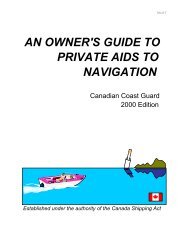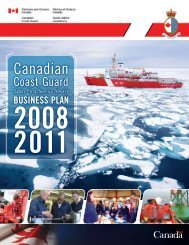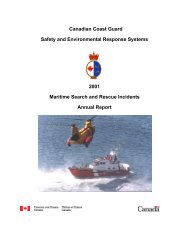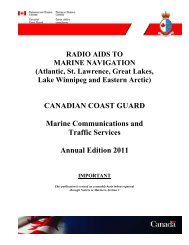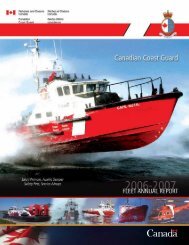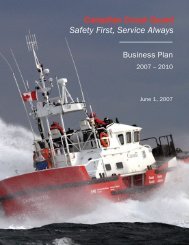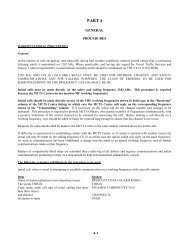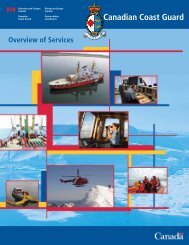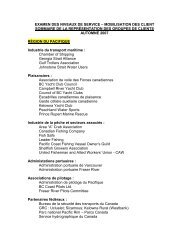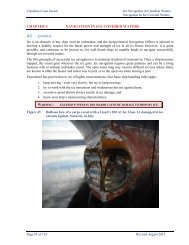RADIO AIDS TO MARINE NAVIGATION - Canadian Coast Guard
RADIO AIDS TO MARINE NAVIGATION - Canadian Coast Guard
RADIO AIDS TO MARINE NAVIGATION - Canadian Coast Guard
You also want an ePaper? Increase the reach of your titles
YUMPU automatically turns print PDFs into web optimized ePapers that Google loves.
SYSTEMS<br />
GMDSS – GLOBAL MARITIME DISTRESS AND SAFETY SYSTEM IN CANADA<br />
What is GMDSS?<br />
The Global Maritime Distress and Safety System (GMDSS) is an international system using improved terrestrial and<br />
satellite technology and ship-board radio systems. It ensures rapid alerting of shore-based rescue and communications<br />
authorities in the event of an emergency. In addition, the system alerts vessels in the immediate vicinity and provides<br />
improved means of locating survivors.<br />
GMDSS was developed through the International Maritime Organization (IMO) and represents a significant change in the<br />
way maritime safety communications are conducted. While it is mandatory for all ships subject to the International<br />
Convention for the Safety Of Life At Sea (SOLAS) (cargo ships 300 gross tons or greater and all passenger vessels, on<br />
international voyages), GMDSS will impact on all radio-equipped vessels, regardless of size. All SOLAS ships are required<br />
to fully comply with GMDSS.<br />
Why GMDSS?<br />
GMDSS was developed to SAVE LIVES by modernizing and enhancing the current radiocommunication system. By<br />
utilizing satellite and digital selective calling technology, GMDSS provides a more effective distress alerting system. It<br />
improves the current system by:<br />
• increasing the probability that an alert will be sent when a vessel is in distress;<br />
• increasing the likelihood that the alert will be received;<br />
• increasing the ability to locate survivors;<br />
• improving rescue communications and coordination; and<br />
• providing mariners with vital maritime safety information.<br />
Maritime Safety Information (MSI)<br />
Maritime Safety Information broadcasts, which comprise distress alerts, SAR information, navigational and weather<br />
warnings, as well as forecasts, can be received in three different ways in GMDSS:<br />
1. NAVTEX receivers are fully automatic and receive broadcasts in coastal regions up to 300 nautical miles offshore;<br />
2. INMARSAT-C terminals receive Enhanced Group Call – SafetyNET (EGC) broadcasts for areas outside NAVTEX<br />
coverage;<br />
3. HF Narrow Band Direct Printing (NBDP) receivers can be used where service is available as an alternate to EGC.<br />
GMDSS Sea Areas – International<br />
Although ship-to-ship alerting is still an important function in GMDSS, the emphasis is on two way communications<br />
between ships and shore facilities. All GMDSS ships must be capable of communicating with the shore and transmitting a<br />
distress alert by two different means. The equipment carried by a GMDSS ship is therefore determined by its area of<br />
operation and the availability of shore-based communications services.<br />
There are four “Sea Areas” defined in the GMDSS:<br />
Sea Area A1 Within range of shore-based VHF/DSC coast station (40 nautical miles)<br />
Sea Area A2 Within range of shore-based MF/DSC coast station (excluding sea areas A1)(150 nautical miles)<br />
Sea Area A3 Within the coverage of an INMARSAT geostationary satellite (approximately 70°N to 70°S) (excluding<br />
sea areas A1 & A2)<br />
Sea Area A4 The remaining areas outside sea areas A1, A2 & A3 (polar regions)<br />
4-9




